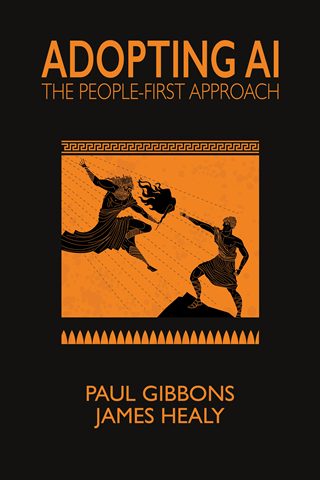Thursday, September 18, 2025
Thursday, September 18, 2025

Excerpted from “Adopting AI: A People-First Approach”, by Paul Gibbons and James Healy:
“If I had asked people what they wanted, they would have said faster horses.” usually attributed to Henry Ford
In early 2024, The Economist reviewed AI adoption rates:
“Most firms do not currently use ChatGPT, Google’s Gemini, Microsoft’s Copilot or other such tools in a systematic way, even if individual employees play around with them… only about 5% of American firms of all sizes said they used AI. A further 7% of firms plan to adopt it within six months… the numbers conceal large differences between sectors: 17% of firms in the information industry, which includes technology and media, say they use it to make products, compared with 3% of manufacturers and 5% of health-care companies.”
Whom to believe? Surveys from consulting firms place this much higher – nearly two-thirds of enterprises are using AI, according to McKinsey. The difference is explained (partly) by a difference between Gen AI and earlier narrow-AI deployments. McKinsey’s method asked about adoption in any single function – perhaps legacy use cases in cybersecurity or chatbots would count. It seems to us that perceived social norms may be a factor – firms are more likely to exaggerate their efforts (because Wall Street) than downplay them, and McKinsey have a vested interest in creating FOMO among potential clients. Anecdotally, in our travels among hundreds of mid-sized companies, The Economist’s data are closer to reality – we met very few senior executives who were much past the AI-curious stage.
Amid the proliferation of hype (not least in this book’s first chapter), you might wonder, why is AI adoption by businesses proceeding at such a sluggish rate?
We are reminded of internet adoption. The world wide web launched in 1993, but it took almost two decades to reach the tipping point that two-thirds of businesses in the US had a website. And having a website is a long way from digital transformation. Many firms simply took their marketing material, digitized it and stuck it on the web as “brochureware”. It wasn’t until the 2010s, with the advent of smartphones, that businesses began to realize they were leaving money on the table. The transformative effect on work and workplaces was arguably only felt nearly 30 years later during the global COVID-19 pandemic as stay-at-home mandates forced businesses across a range of sectors to radically virtualize their operating models and finally prioritize digital first.
While most established corporations just tinkered with the Internet for two decades, the so-called “FANGs” (Facebook, Amazon, Netflix, Google) ate their lunch. Bricks-and-mortar book sales fell 75%, and Amazon captured 50% of the $20bn book market. PayPal birthed the online payments industry; Facebook crushed the social media businesses of Friendster (huh?) and Myspace (who?). Netflix invented an entirely new category, wiping out a range of established competitors up and down the media value chain.
Sure, in early 2025, the hype herd may be stampeding toward an AI-enabled future, but most executives will remember management fads that generated more heat than light: Business Process Redesign, Six Sigma, Total Quality Management, the Metaverse, and the Y2K “bug”.
Silver bullets have an uncanny tendency to miss the mark. Many will remember the 90% crash in the NASDAQ during the “dotbomb” crisis at the turn of the century, when the “next big thing” had an uncomfortable collision with reality. Are we at max hype, or internet-1993? Is the party just getting started?
===
Adopting AI: A People-First Approach is now available on Amazon.
Written by: Editor
© 2025 Stratpair Ltd., trading as Strategic. Registered in Ireland: 747736